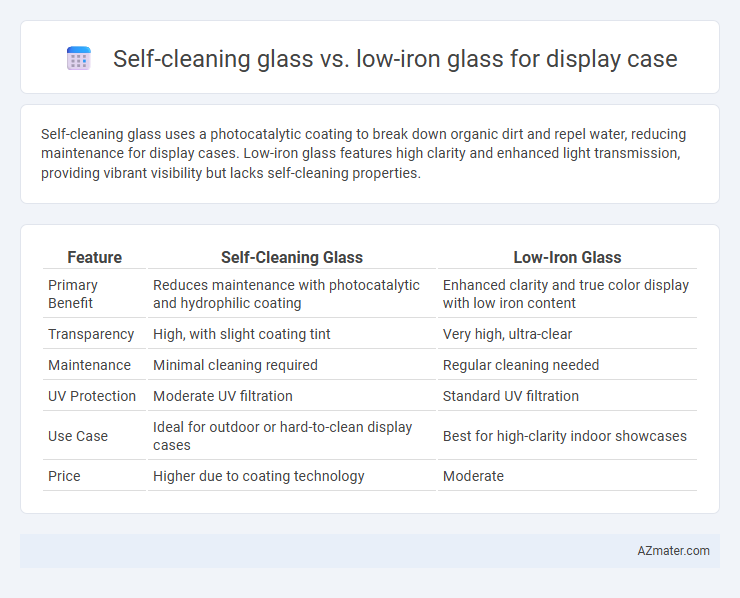Self-cleaning glass uses a photocatalytic coating to break down organic dirt and repel water, reducing maintenance for display cases. Low-iron glass features high clarity and enhanced light transmission, providing vibrant visibility but lacks self-cleaning properties.
Table of Comparison
| Feature | Self-Cleaning Glass | Low-Iron Glass |
|---|---|---|
| Primary Benefit | Reduces maintenance with photocatalytic and hydrophilic coating | Enhanced clarity and true color display with low iron content |
| Transparency | High, with slight coating tint | Very high, ultra-clear |
| Maintenance | Minimal cleaning required | Regular cleaning needed |
| UV Protection | Moderate UV filtration | Standard UV filtration |
| Use Case | Ideal for outdoor or hard-to-clean display cases | Best for high-clarity indoor showcases |
| Price | Higher due to coating technology | Moderate |
Introduction to Display Case Glass Options
Display case glass options include self-cleaning glass and low-iron glass, each offering unique benefits for clarity and maintenance. Self-cleaning glass features a photocatalytic coating that breaks down organic dirt when exposed to sunlight, reducing cleaning frequency. Low-iron glass provides exceptional transparency and color accuracy by minimizing the green tint typical in standard glass, enhancing product visibility in display cases.
What is Self-Cleaning Glass?
Self-cleaning glass is coated with a special titanium dioxide layer that uses sunlight to break down organic dirt and rainwater to wash it away, ensuring clearer visibility and reduced maintenance for display cases. This photocatalytic and hydrophilic coating significantly decreases the need for manual cleaning compared to low-iron glass, which is valued primarily for its clarity and reduced green tint but lacks dirt-repelling properties. Incorporating self-cleaning glass in display cases enhances both aesthetic appeal and long-term durability while maintaining optimal transparency.
Key Features of Low-Iron Glass
Low-iron glass for display cases offers superior clarity and color accuracy due to its reduced iron content, which minimizes the greenish tint found in standard glass. Its high light transmittance enhances product visibility, making it ideal for showcasing valuable or detailed items. This glass type also provides excellent durability and scratch resistance, ensuring long-lasting visual appeal in retail or museum environments.
Clarity and Visual Appeal Comparison
Self-cleaning glass incorporates a photocatalytic coating that breaks down organic dirt and repels water, maintaining clarity by reducing smudges and grime on display cases, whereas low-iron glass offers superior visual appeal through enhanced transparency and reduced green tint, resulting in truer color representation. Low-iron glass is often preferred for high-end display cases requiring maximum optical clarity and vibrant product presentation. While self-cleaning glass aids in maintenance and prolonged cleanliness, low-iron glass excels in delivering unmatched clarity and aesthetic precision.
Maintenance and Cleaning Requirements
Self-cleaning glass significantly reduces maintenance efforts by utilizing a photocatalytic coating that breaks down organic dirt and allows rainwater to wash away residues, minimizing manual cleaning frequency. Low-iron glass, while providing higher clarity and better color transmission for display cases, requires regular cleaning with standard methods to maintain its pristine appearance as it lacks any dirt-repellent properties. Choosing self-cleaning glass for display cases lowers overall cleaning time and costs, whereas low-iron glass demands consistent upkeep to prevent smudges and dust accumulation.
Durability and Resistance to Damage
Self-cleaning glass for display cases offers enhanced durability through its hydrophilic coating that resists dirt buildup and minimizes scratches, maintaining clarity over time. Low-iron glass provides superior resistance to discoloration and edge chipping due to its high purity and reduced iron content, ensuring long-lasting visual performance. Both glass types improve the lifespan of display cases, but self-cleaning glass excels in reducing maintenance-related wear, while low-iron glass offers exceptional structural integrity against physical damage.
UV Protection and Light Transmission
Self-cleaning glass for display cases offers enhanced UV protection by incorporating a photocatalytic coating that breaks down organic dirt and filters harmful ultraviolet rays, maintaining clarity and reducing fading of displayed items. Low-iron glass is prized for its superior light transmission, typically exceeding 90%, due to its reduced iron content, which minimizes the greenish tint found in standard glass; however, it provides limited UV protection unless combined with additional coatings. Selecting between self-cleaning and low-iron glass depends on prioritizing UV filtering capabilities versus maximizing natural light visibility in display cases.
Cost Considerations and Value
Self-cleaning glass for display cases typically has a higher upfront cost due to its specialized coating technology that reduces maintenance expenses over time. Low-iron glass, while more affordable initially, offers enhanced clarity and color accuracy but may require more frequent cleaning and care, potentially increasing long-term costs. Evaluating the balance between initial investment and maintenance savings is crucial for optimizing display case value based on usage and environmental factors.
Best Use Cases for Display Cases
Self-cleaning glass is ideal for display cases in outdoor or high-dust environments, minimizing maintenance by breaking down organic debris and rinsing away dirt with rain or water. Low-iron glass offers superior clarity and color accuracy, making it the best choice for museums, galleries, or retail displays where true color representation and high transparency are crucial. Combining both types enhances display aesthetics and reduces upkeep, but selection depends on prioritizing either ease of maintenance or optical performance.
Choosing the Right Glass for Your Display Case
Self-cleaning glass reduces maintenance by using a photocatalytic coating that breaks down organic dirt and allows rainwater to wash it away, ideal for outdoor or hard-to-reach display cases. Low-iron glass offers superior clarity and true color representation with its reduced iron content, making it perfect for indoor display cases requiring high transparency and enhanced visual appeal. Choosing the right glass depends on prioritizing either easy upkeep with self-cleaning technology or optimal clarity with low-iron composition for showcasing valuable items.

Infographic: Self-cleaning glass vs Low-iron glass for Display case
 azmater.com
azmater.com